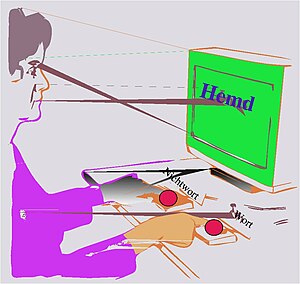Word superiority effect
The word superiority effect means that a reader recognizes whole words of a language faster and with a smaller error rate than single letters and non-words (random letter combinations) which are composed of the same letters. Letters are therefore easier to identify within a word than if they are displayed individually or in masked form (for example within a sequence of letters such as XXXXX). The word recognition therefore runs from liquid. This finding is considered to be the main evidence of the dynamic and active nature of speech perception .
If the processing of visual information is already very efficient, then the processing of written language is also organized through the word superiority effect. The efficiency of the reading process is measured by the reading speed. The reader reads an average of 250-300 words per minute. This results in a time span of only 200-300 milliseconds per word.
The word superiority effect is more pronounced with longer letter sequences than with shorter ones. This also applies to a longer latency period between the presentation of the stimulus and the choice of reaction . It follows that the most striking difference between processing words and receiving other visual stimuli is that the brain translates words into an efficient memory mode more quickly. It is assumed that the sequence of letters is mapped to linguistic structures that have already been stored. On the one hand, these structures can be words stored in the internal lexicon. On the other hand, the translation process can also be a productive system that enables the formation of new forms in a language (an explanation of the pseudo-word superiority ). Phonological recoding is one of the options for transmission.
Common words do not show superiority over less common words.
Test setup
Result
See also
- Priming ( facilitating , semantic priming )
swell
- H. Günther: Studies on visual word recognition. 1983, 1-190
- Helmut Glück (Ed.): Metzler Lexicon Language. 2000
- Study by Meyer u. Schvaneveldt 1971

